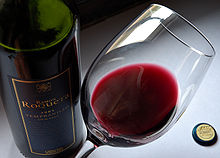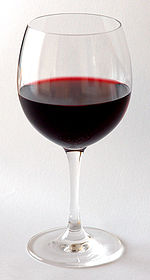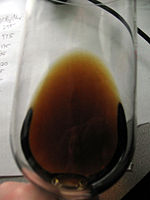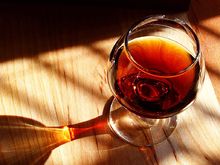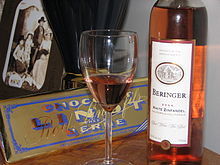- Wine color
-
The color of wine is one of the most easily recognizable characteristics of wines. Color is also an element in wine tasting since heavy wines generally have a deeper color. The accessory traditionally used to judge the wine color was the tastevin, a shallow cup allowing to see the color of the liquid in the dim light of a cellar. The color is an element in the classification of wines.
Contents
Color origins
The color of the wine mainly depends on the color of the drupe of the grape variety. Since pigments are localized in the exocarp (skin) of the grape drupe, not in the juice, the color of the wine depends on the method of vinification and the time the must is in contact with those skins, process called maceration. Teinturier grape is an exception in that it has also a pigmented pulp. The blending of two or more varieties of grapes can explain for the color of certain wines, like the use of Australian Rubired.
Red drupe grapes can produce white wine if they are quickly pressed and the juice not allowed to be in contact with the skins. The color is mainly due to plant pigments notably phenolic compounds (anthocyanidins, tannins ...). The color depends on the presence of acids in the wine. It is altered with the wine aging by reaction between the different active molecules present in the wine, these reactions generally giving rise to a browning of the wine, leading from red to a more tawny color. The use of a wooden barrel (generally oak barrels) in aging also affects the color of the wine.
Part of the color of a wine can be due to co-pigmentation of anthocyanidins with non pigmented other flavonoids or natural phenols (cofactors or “copigments”).[1]
Rosé wine is made by the practice of saignée or by blending a white wine with a red wine.
Color evolution
The presence of a complex mixture of anthocyanins and procyanidins can increase the stability of color in wine.[2]
As it ages, the wine undergoes chemical autoxidation reactions involving acetaldehyde of its pigments molecules. The newly formed molecules are more stable to the effect of pH or sulfite bleaching.[3] The new compounds include pyranoanthocyanins like vitisins (A and B), pinotins and portosins and other polymeric derived pigments.[4]
Castavinols are another class of colorless molecules derived from colored anthocyanin pigments.
Colors
Main colors of wine are :
- red
- white (light colored wine)
- Rosé (pinkish in color)
- yellow (or straw color), see for instance vin jaune, a special and characteristic type of white wine made in the Jura wine region in eastern France, Jurançon or Sauternes
- Orange wine, a white wine that has spent some time in contact with its skin, giving it a slightly darker hue
- Tawny, as in tawny port.
Other :
- Burgundy (color), a shade of purplish red
- Sangria (color), a color that resembles Sangría wine
- Ox blood, probably referring to ancient practice of fining red wines with dry powdered blood
Scientific color determination
The International Organisation of Vine and Wine (OIV) provides methods to assess the color of a wine using a spectrophotometer and the calculation of indices in the Lab color space.[5]
See also
- Glossary of winemaking terms
- Wine (color) or "Burgundy", the color of red wine
References
- ^ Boulton, Roger (2001). "The Copigmentation of Anthocyanins and Its Role in the Color of Red Wine: A Critical Review". Am. J. Enol. Vitic. 52 (2): 67–87. http://www4.napavalley.edu/Projects/1158/Fundamentals_of_Enology_Class/Copigmentation_Boulton.pdf.
- ^ Céline, Malien-Aubert; Olivier, Dangles; Josèphe, Amiot Marie (2002). "Influence of procyanidins on the color stability of oenin solutions". Journal of agricultural and food chemistry 50 (11): 3299–3305. doi:10.1021/jf011392b.
- ^ Atanasova, Vessela; Fulcrand, Hélène; Cheynier, Véronique; Moutounet, Michel (2002). "Effect of oxygenation on polyphenol changes occurring in the course of wine making". Analytica Chimica Acta 458: 15–27. doi:10.1016/S0003-2670(01)01617-8.
- ^ Schwarz, Michael; Hofmann, Glenn; Winterhalter, Peter (2004). "Investigations on Anthocyanins in Wines from Vitis vinifera cv. Pinotage: Factors Influencing the Formation of Pinotin A and Its Correlation with Wine Age". J. Agric. Food Chem. 52 (3): 498–504. doi:10.1021/jf035034f.
- ^ OIV web site
External links
Wikimedia Foundation. 2010.

